by Judith Ann Isaacs
Introduction
The Jemez Springs Public Library came into being through the persistence and dedication of a group of local residents, who volunteered endless hours during the decades of 1960s through the early 1990s. Few had training or experience as librarians. What they had was a love of books and reading and a belief that any self-respecting community should have a library open to the public where adults and children could borrow books. And books it was at that time. It wasn’t until the early 2000s that the collection included audio books, first on cassette and then CD, and movies on DVD.
Like an orphan, the original book collection was moved several times until the Village adopted it and gave it a permanent home. The initial structure has undergone four remodels to date, each one improving and expanding the library as funds became available to accommodate the community’s needs.
Beginnings
The library was started in 1965 by Grace Swetnam and Katie Evilsizer, of Farmington, in a corner of the vestibule on the lower level of the Jemez Springs Presbyterian Church. The original holdings were obtained when Jack Dilley, minister at that time, donated his personal collection. According to an article in The New Mexican on April 2, 1965, books were also furnished by the New Mexico Library Extension Service through the assistance of Miss Virginia Real, Aztec librarian. Hours were 3-6 pm on Tuesdays and Thursdays during the school year and noon-6 pm in the summer. Grace Swetnam was the librarian and was aided by a number of volunteers. A copy of a photo from News of Northern New Mexico, Friday, April 2, 1965, provided by her son, Tom Swetnam, shows Grace and Katie, who also arranged for the Northwest Regional Library Bookmobile to make stops in Jemez Springs.
In addition to Patricia, Lupe Casaus also served volunteered as an assistant librarian.
The library soon moved to a room in the old electric coop building (since torn down and replaced with existing the Jemez Mountain Electric Coop). The State Library provided enough books to line two walls, and State Library consultants provided assistance in library skills. In addition to books on a rotating loan from the State Library, the collection consisted of donations from the public. The library was open two afternoons on week days.
The Jemez Springs Community Library was officially established in 1973 under the incorporation of the Village of Jemez Springs when Josephine Shepherd was mayor. At a later date, the library moved from the electric coop to a room in the Jemez Springs Bath House. Hours during this period increased from two to four hours per day. Bill Guse, Shelly Quiner, Linda Soroos, Anita (Neetie) Treston, Ed Torrup, Linda Domier and Susan Holmes served as librarians in these two locations—all as volunteers.
Permanent Building–First Remodel/First Library Board
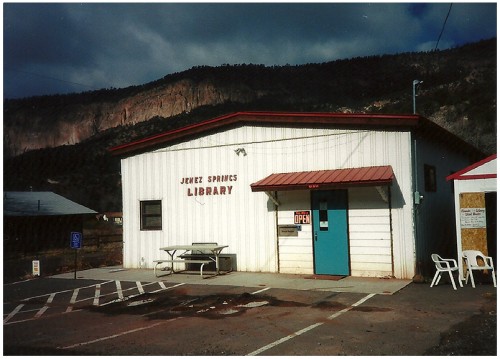
The Community Club owned an 800 sq. ft. metal storage building located at the south end of the Village Plaza. Primary use was a place to store the life-size figures that comprised Christmas decorations placed each year on Soda Dam and subsequently in Fr. Fitzgerald Park. The Club donated the site to the Village, and in 1984, Mayor Maudell Berglund applied for a grant to remodel the building for use as a library. That original storage building comprises the southernmost section of today’s library.
In 1992, the Village, under Mayor Genevieve Sandoval, adopted Resolution #177, which formally established a library director and a library board, both being required of what was termed a “developing” library by the State Library. Susan Minter became Library Director and held that position until 1996.
The first library board members were Bill Guse, president; Paul Wenninger, vice president; Theresa Millard, secretary-treasurer; Ron Malpass, representative trustee from the Village. In 1995, Kathleen Weigner became secretary-treasurer, and Roger Sweet became Village representative. The original library policies were written by Paul Wenniger, Rebecca Christman, Kathleen Weigner, Roger Sweet and Susan Minter.
Amy (Grimes) Pearson was the librarian. In the next few years, the library entered the electronic age when one Apple computer was added for public access, and a PC was purchased for the librarian. Hours increased to 10-6:30 three days per week plus noon-4 on Saturdays. In 1994, a Memorandum of Agreement was signed by the Village of Jemez Springs and Sandoval County that recognized the service of the library extended far beyond the Village limits. It was therein defined as stretching from San Ysidro to Seven Springs and from Ponderosa to Sierra Los Pinos. This increased the amount of funding available from both the county and the state.
Friends of the Library
From the very beginning right up to the present day, the library has been sustained by volunteers. They have raised funds through memberships, raffles, silent auctions, used book sales, benefits at Hummingbird Music Camp, generous gifts, and many, many bake sales. Nancy Cella, a long-time member and officer of the Friends of the Library, looked up from a sales booth in the park on a hot summer day, gestured to the library and said, “Look what a million brownies can build.” Volunteers have staffed the front desk, presented programs, served on the board, shelved books, sorted donations, and assisted with myriad other tasks that would have been difficult to complete without them.
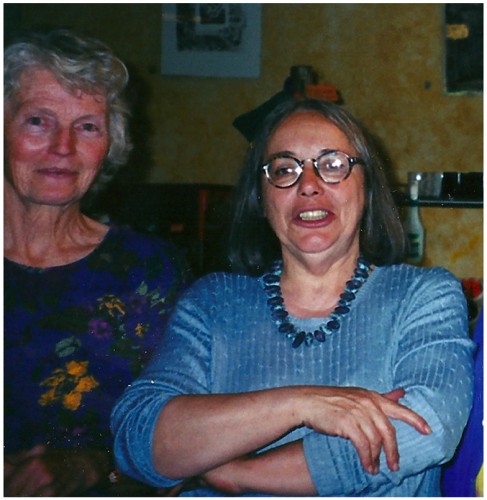
In 1993, the Friends of the Library (FOL) became a 501c3 non-profit corporation in order to better raise funds for the library. Two women were influential in moving the library toward a full-service institution: Rebecca Christman, retired university librarian and president of the Library Board, and Kathleen Wiegner, author, local newspaper editor and president of Friends of the Library. The year before, Donna Lea had started the process by putting out a call for volunteers, according to an article in the Jemez Jonker (May 1992).
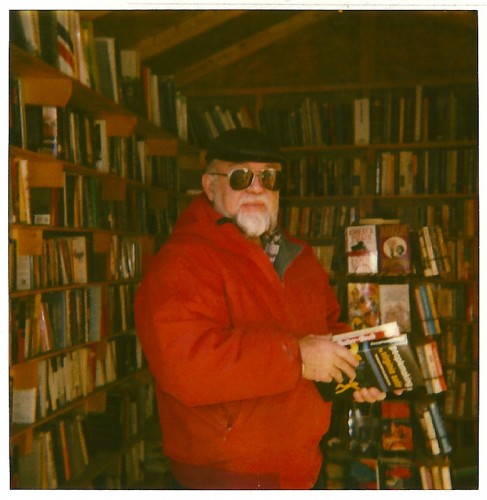
The Friends purchased a shed which became the “Book Barn,” currently located behind the library. Stocked with donations from the public and items withdrawn from the library collection, it is another significant fund-raiser. Jim McClary for many years volunteered to keep the Book Barn organized and was the first to identify books to sell on E-Bay to benefit the Friends of the Library.
Regular fund-raising events for many years were the Sunday Salons, which ranged in subject matter from native plants to poetry writing to travelogues. These events were publicized by a series of striking posters designed by artist Erica Kane, president of the Friends from 1999 to 2015. To see more of Erica’s posters, go to Collections.
We are most likely the only library in the country, maybe the world, to have been partially funded through yoga classes, which were started in 2007 by volunteer Chris Gardner. Over many years, other volunteers with yoga training continued teach a weekly yoga class on a donation basis. All proceeds went to the Friends of the Library.
Two significant donations were big fundraisers for the Friends. The first occurred in 2013 when Peter Reynolds, a part-time resident of the Valley, donated his personal collection of Southwest art, including paintings, pottery and sculpture. The Friends decided to keep work of all local artists, which today graces the walls and shelves, once again making Jemez Springs Public Library unique among the many small-town libraries in the state by owning and displaying a world-class art collection. Through E-bay and in-house auctions, the remainder of the collection was sold. In 2015, Anne Hillerman, daughter of famed New Mexico mystery writer Tony Hillerman, donated her father’s personal library to the Friends of the Library. The extensive collection of first editions, foreign language copies of his books, and other memorabilia has been divided to benefit the library in several ways. Some were added to the collection, some became part of a permanent exhibit, and the remainder have been sold to benefit the library.
Second Remodel
In 1996, the Village received a grant for $25,000 and embarked on a second remodel. With additional funds from Friends of the Library and Sandoval County, the building was expanded by 300 sq. ft. (now the small room that leads to the deck), and other parts of the building were brought up to code.
New Librarian: Judith Isaacs
Judith Isaacs became library director in 1996; her part-time assistant was Grainne Rowland. Judith had not trained in library science; her degree was a Masters in Educational Administration. A lifelong avid reader, she said she had “spent an awful lot of time in libraries.” For the first couple of years after she became director, Judith was also Story Lady.
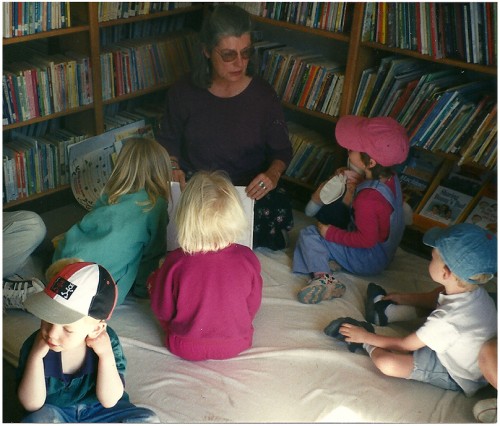
In 1997, the library became certified as a public library, having met all criteria established by the State. With public library status came regular funding from the state for collection development and staff training, as well as eligibility for inclusion in state and county bond issues. Hours expanded to 38 hours per week to meet State requirements.
With strong support from Mayor David Sanchez and using grants and funding from the Friends of the Library to supplement these new sources of revenue, a number of programs, mostly for children and youth, were instituted in the next few years. Included were Summer Reading Programs, outreach to the school district with Battle of the Books, and Land of Enchantment, open mike poetry reading, Chess Club, book discussion group, home-school reading group and resource center. Children were always involved in creating and riding in the library’s Fourth of July floats, several of which were awarded prizes. For more photos of library children’s programs, go to Library Images.
Isaacs revived preschool storytime for 3- and 4-year-olds, which Susan Minter had started. Judith read to toddlers for a year, then Christine Barton became Youth Program Coordinator and Story Lady. In 2004, Margaia Forcier-Call volunteered to be the Story Lady and continued for 9 years. While many of programs depended on volunteers, no volunteer was more faithful than Margaia, who shared her memories of the experience.
Another program that has been a constant throughout the years is a book discussion group. It grew into a library program from an informal book club that met in members’ homes. Among the original members were Kathleen Wiegner and Robert Borden, Jess and Becky Christman, Kimberly Childs, Barbara and John Curran.
Library Goes Digital
When asked what she was most proud of during her years as Library Director, Judith said it was getting the collection cataloged and instituting an electronic circulation system. “When I started, the books were shelved roughly into subject categories, but there wasn’t so much as a card catalog. Since card catalogs everywhere were being replaced with computerized catalogs, we went straight to that type of system. When I came, books were checked out by the librarian writing the name of the patron and the name of the book in a notebook. We were really starting from scratch.” (Susan Minter reported that she had started a card catalog and had the traditional wooden case for it. However, no trace of it was found in 1996.)
It took about 5 years, a grant from New Mexico Library Foundation and lots of volunteer help to catalog the approximately 10,000 items in the collection. In addition to creating a catalog entry for each book, a card pocket was pasted in and a circulation card inserted where patrons at first wrote their names. 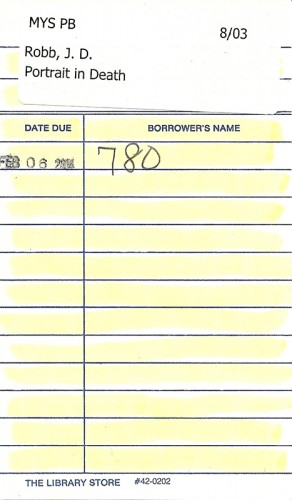 When money became available for new software, cardboard library cards with numbers were issued, and patrons were asked to write their number instead of their name. Many patrons complained about this because they wanted to (a) see if they had read the book before and (b) see who else had read it. Patrons didn’t see the necessity of library cards anyway. After all, everybody knew everybody else. While cards issued today have four-digit numbers, a few people are still around who have single and double digit library card numbers.
When money became available for new software, cardboard library cards with numbers were issued, and patrons were asked to write their number instead of their name. Many patrons complained about this because they wanted to (a) see if they had read the book before and (b) see who else had read it. Patrons didn’t see the necessity of library cards anyway. After all, everybody knew everybody else. While cards issued today have four-digit numbers, a few people are still around who have single and double digit library card numbers.
Third Remodel
As more money became available for capital improvement, the library embarked on another remodel in 2000. This one resulted in adding the deck in the back and portal in the front, as well as stuccoing the building, installing energy efficient windows, remodeling the interior, and replacing all the shelving. In addition to being a pleasant place to read and listen to the river, the new deck was used for the re-opening reception and for a variety of programs.
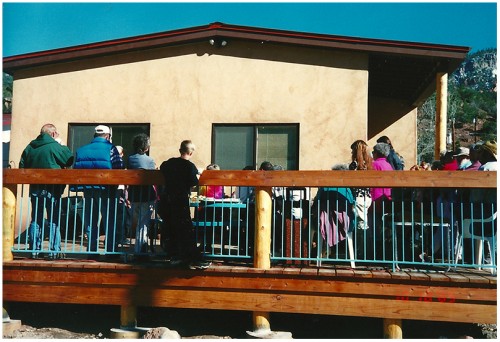
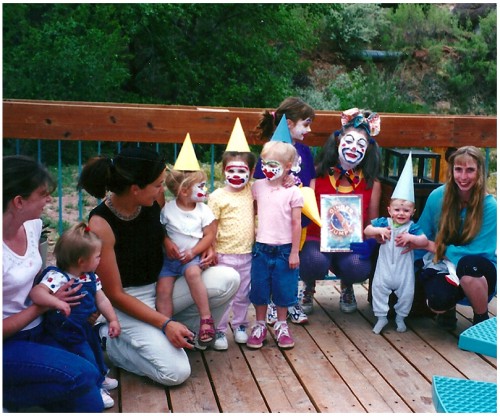
Once this remodel was complete, funding became available through the Friends and the Village to add a part-time children’s librarian, titled Youth Programs Coordinator. The first to hold this position was Christine Barton, formerly an elementary school teacher, now a yoga teacher in New York state. Others who worked in the children’s programs over the years included Donna Lea, Carol Meine, Janet Phillips, and Deborah Williams.
Click here for more photos.
The Library Becomes Famous: Tri-Cultural Authors Symposium
In 2001, the Friends, under the leadership of volunteer Morris Taylor, organized a Tri-Cultural Symposium, the first of what would become an annual event that literally put the tiny Jemez Springs Public Library on the map. Morris’s vision was that the symposium would feature New Mexico authors who represented the three cultures in our state (and in our community): Native American, Hispanic and Anglo. The programs would be free to the public; donations were encouraged. Through his immense powers of persuasion and the goodwill and love of libraries manifested in even the most famous, the first symposia featured the blockbuster trio of Tony Hillerman, Rudolfo Anaya and N. Scott Momaday. Each was internationally famous in his own right, and the opportunity to see all three together on the same stage was unprecedented. The resulting publicity attracted people from all over the U.S.
The only compensation any of them ever received was a dinner for themselves and a guest at the Laughing Lizard Cafe and one night’s lodging at the Dancing Bear B&B. While none of the succeeding events reached the luster of the first, the symposia continued for five more years, featuring these well-known New Mexico authors:
2002: Denise Chavez, Simon Ortiz, Michael McGarrity
2003: John Nichols, Rina Swentzell, Demetria Martinez
2004: Simon Ortiz, Paula Gunn Allen, Judith Van Gieson
2005: Nasario Garcia, Jim Belshaw, Joe Sando
2006: Lee Marmon, Thomas Chavez, Ferenc Morton Szasz
2008: Jane Lindskold, Stephen R. Donaldson, Walter Jon Williams
Local artists contributed to unique posters that advertised each symposium. Pictured here is the poster for the first signed by the authors. Go to Collections to see the others, most of which are signed by participating authors.
Fourth Remodel
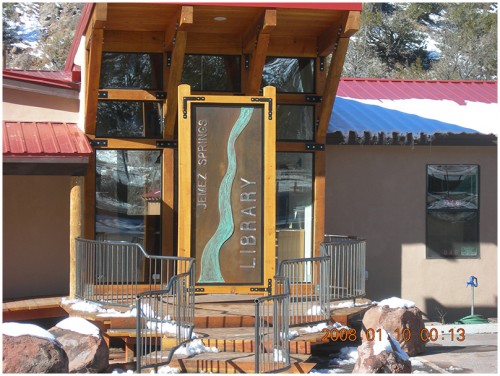
The most recent remodel, completed in 2008, resulted in the library you see today. Mayor Johnnie Garcia, with approval from the Village trustees, for two consecutive years placed the library as a top priority in his request to the state for capital improvement funds earmarked by the legislature for small communities. That funding, plus once again state and county bond issues and Friends of the Library, enabled the Village to create the beautiful, expanded structure you see today. In addition to pushing for state capital improvement funds, the Village decided to move its offices to another building and make their former office space, a double-wide mobile home, available to the library. With the vision of architect Bob Hall, subsequently a principal at Integrated Design & Architecture, the two dissimilar buildings were joined. The former double-wide is now the children’s area, computer area, teen room and restrooms. The old conference room remains as a multi-use venue for the Village.
The library celebrated its 50th anniversary in April 2005. The program featured three well-known New Mexico authors: N. Scott Momaday, Anne Hillerman, and Nasario Garcia.
The following articles were added by Janet Phillips March 2025
New Librarian: Eva Jacobson
Eva Jacobson followed Judith as the Library Director and served from February 2008 – January 2014.
Eva shepherded the library into the world of electronic books. She helped establish the first e-book consortium in New Mexico, made possible by a significant Library Services and Technology Act (LSTA) grant which the group won through the State Library. She provided extensive advertising and training to the public – even inviting the mobile technology bus from New Mexico State Library (NMSL) for people to see all of the options.
Eva also worked on a big state-wide broadband project which sought to enhance connectivity for rural communities. Simultaneously, she worked with the library’s internet provider to negotiate a contract to double the service capacity. The goal was to make the library a local hub in an area where service at the time was spotty at best.
Eva migrated the library collections into our first online catalog, Integrated Library System (ILS), which was carefully selected to enhance online access. The project required an extensive clean-up of the existing material records. Some plans for aligning JSPL with three consortium partners who all used the same ILS were explored to gain some degree of collaboration/material exchange/integration of catalogs. The project collapsed when several of the original directors in the group retired or moved on, but the creative thought was significant.
New Librarian: Carol Meine
Carol Meine followed Eva as Library Director and served from February 2014 – December 2015
Carol had worked at JSPL for Judith Isaacs as an assistant, then gained more years of library experience at Los Alamos Libraries before returning to JSPL as Director. Carol brought excellent collection development skills and led the library through a period of strong readership and participation in adult reading challenges.
Carol oversaw the creation of the Jemez Valley History website, which continues to grow in content. Carol obtained assistance via Brandi Daw, AmeriCorps Jemez History Project Intern. Brandi, a student at Highlands University, worked extensively with volunteer Judith Isaacs and Village IT Greg Shores to establish the website.
Carol orchestrated a fabulous 50th Anniversary celebration of the library in 2015.
New Librarian: Janet Phillips
Janet Phillips followed Carol as the Library Director and served from February 2016 – March 2025.
Janet had worked at JSPL for Judith Isaacs as an assistant, then gained more years of library experience as a Youth Service Librarian at Rio Rancho Libraries before returning to JSPL as Director. Janet brought extensive programming experience as well as a systems approach learned via previous engineering and management experience. Programming and events for all ages at the library were increased via community involvement, volunteers, library staff, and generous Friends of the Library funding.
Systems and service improvements included a new website which also provided public-facing policy and Library Board information, an online staff journal for communications and statistics collection, policy development to bring the library up to date, budget restructuring, digital equity improvements, and the addition of a Library of Things. Grant-funded initiatives included a New Mexico Library Foundation grant to issue digital access library cards to all Jemez Valley Public Schools students, as well as an American Library Association, Libraries Transforming Communities grant which funded Community Conversations, an intense effort involving volunteers from the Library Board & FOL Board, with a goal of understanding and enabling improvements in area communications.
Janet guided the library through the era of social distancing and curbside service induced by the Covid pandemic. Service changes included extensive online resources added to the website with a focus on economic/business/education/mental health, curbside services and to-go activities, Neighborhood Warm Line, zoom and hybrid programming, added safety devices and procedures, lockers for 24/7 hold pick up, increased circulation via volunteers to provide access to free books via community bookshelves in Ponderosa, San Ysidro, and La Cueva in addition to the existing service to the Canon Community Center.
From June 2023- June 2024 the library building experienced moisture damage which cause the growth of mold above the ceilings. The Jemez Springs Community Presbyterian Church welcomed the library back into the church building, where it originated, to enable the library to continue to serve the community while the library building was repaired.
Library staff and independent contractors working at the library contributed hugely to the library’s success over the years and included (recent to previous): Amanda Lewis, Annie Riley, Rose Marie Mauzy, Hailey Cooper, Nancy Swanson, Roz Coates, Damien Spencer, Nora Sutherland, Stevan Patillo, Kiki Perry, Hadassah Fragua, Gary Martinez, Diane Duback, Cynthia East, Savannah Gilbert, Lauren Caffrey. Several people worked over the years to keep the library clean, and several youth interns via Sandoval County helped out in the summers. Volunteers are also always an appreciated and necessary aspect of rural libraries.
Building Improvements
Carol Meine oversaw the installation of solar shades on windows throughout the library. Janet Phillips followed the path of reducing heat gain with the installation of a heat-reflective window film (local business Sam’s Glass) on the entryway glass, shade sails on the back deck (Chad Bell, Village Maintenance department), and a veranda shade over the south facing windows (designed by local architect Tom Mnich and built by local builder Daniel/Lori Forsythe). The northern A/C unit was also replaced in 2015.
A 2015 conference room remodel (designed by local architect Tom Mnich and built by Daniel/Lori Forsythe) made the multi-use room more user friendly with new carpet, LED lighting, and wooden trim. In 2020, while the library was closed to access due to the pandemic, local woodworker Doug Parker custom-designed and built a new front desk with storage cabinets and a new in-wall bookshelf in the children’s area. He also replaced old tile flooring in the children’s area/kitchen/bath. In 2022 security upgrades of cameras and door locks were installed for staff and patron safety.
In June 2023 the library building was vacated to accomplish moisture damage repairs and mold remediation. Funding challenges and discoveries of additional damages to the building from ice damming extended the timing of the project for a full year. Most of this project was to get the building back to good condition. However there were two improvements: extension of the roof behind the desk area to protect previously exposed wooden beams from absorbing moisture and replacement of archaic florescent lighting with LED lighting throughout. Funding was ultimately provided via Sandoval County Library GO Bonds, insurance, and contributions by the Friends of the Library. This project could not have been accomplished without the tremendous efforts of many, many volunteers who packed up books and furniture to move to the church or store in pods in front of the library for the duration of the project and the many volunteers who helped move books and furniture back into the library and return books to the shelves. The 2024 annual volunteer appreciation event included invitations to over 50 volunteers, many who helped with the moving!
Friends of the Library Updates
While the membership, leadership, and methods changed over the years, the Friends of the Jemez Springs Library has provided consistently amazing support to the library!
The current (2025) long-time President of the Friends of the Library Board is Suzanne Swetnam. Suzanne’s mother-in-law Grace Swetnam was one of the founders of the library, and the entire Swetnam family has made significant contributions of time, energy, and funds over the years. This has included the annual wrangling of the rubber ducks after the July 4th annual fundraising Duck Race! Suzanne has led the FOL Board through transitions including development of a Memorandum Of Understanding governing the communications and relations between the library, library board, and FOL board, and many new fundraising ideas and efforts.
While the library created more event and programming opportunities for the population, Suzanne led the efforts to find other ways to raise funds to support the effort. FOL fundraising gently migrated away from bake sales and towards creative fundraising efforts including art auctions, rare book sales, accepting vehicle donations, in-library book sales by select local authors, special guest science lectures, guided geology and history tours, raffles for guided fishing expeditions, and more!
The Book Barn sales have continued with online sales being accomplished by volunteer Benjamin Green while former director Judith Isaacs leads a team of volunteers to organize the Book Barn and conduct occasional book sales at local events in the park.
Volunteers are at the heart of the library! Without volunteers, the library could not maintain the level of services provided. There are too many amazing volunteers to name here. I will highlight that Nancy Cella, mentioned in Judith’s article above, has been back on the FOL Board serving again after having retired after 14 years of service! Other recent long-serving FOL Board members have included Beverly Musgrove and Dee Plana.
